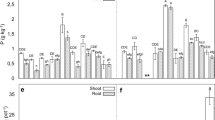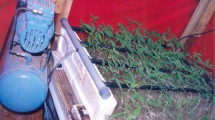Abstract
A range of pasture grass (Danthonia richardsonii and Phalaris aquatica) and legume (Medicago polymorpha, M. sativa, Trifolium repens and T. subterraneum) species showed limited capacity to obtain phosphorus (P) from inositol hexaphosphate (IHP), when grown in either sterile agar (pH 5.0 or 5.5) or sand-vermiculite media (pH 5.0). The total P content of shoots from IHP-supplied plants grown in agar was between 20% and 34% of that for seedlings supplied with an equivalent amount of P as inorganic phosphate (Pi), while in sand-vermiculite, the total P content of IHP-grown plants was between 5 and 10% of control plants. The poor ability of plants to utilize P from IHP resulted in significantly lower tissue P concentrations and, in general, reduced plant dry weight accumulation. In contrast, the P nutrition of plants supplied with IHP was significantly improved by inoculating media with either a cultured population of total soil micro-organisms or with a specific isolate of Pseudomonas sp., selected for its ability to release phosphate from IHP (strain CCAR59; Richardson and Hadobas, 1997 Can. J. Micro. 43, 509-516). In agar and sand-vermiculite media, respectively, the P content of IHP-grown plants increased with inoculation by up to 3.9- and 6.8-fold, such that the dry weight and P content of the plant material were equivalent to those observed for control plants supplied with Pi. However, the response to inoculation was dependent on the growth medium and the source of micro-organisms used. In sand-vermiculite, the cultured population of soil micro-organisms was effective when IHP was supplied at an equivalent level of Pi required for maximum plant growth. By comparison, inoculation of plants with the Pseudomonas strain was only effective at very high levels of IHP supply (×36), whereas in agar a response to inoculation occurred at all levels of IHP. The ability of pasture plants to acquire P from phytate was, therefore, influenced by the availability of IHP substrate, which was further affected by the presence of soil micro-organisms. Our results show that in addition to having an effect on the sorption characteristics of the growth media, soil micro-organisms also provided a source of phytase for the dephosphorylation of phytate for subsequent utilization of Pi by plants.
Similar content being viewed by others
References
Adams M A and Pate J S 1992 Availability of organic and inorganic forms of phosphorus to lupins (Lupinus sp.). Plant Soil 145, 107–113.
Anderson G 1964 Investigations on the analysis of inositol hexaphosphate in soils. In Eighth International Congress of Soil Science. Vol. 4, pp 563–572. Bucharest, Romania.
Anderson G 1980 Assessing organic phosphorus in soils. In The Role of Phosphorus in Agriculture. Eds. FE Khasawneh, EC Sample and EJ Kamprath. pp 411–432. Amer. Soc. Agron., Madison.
Barrett-Lennard E G, Dracup M and Greenway H 1993 Role of extracellular phosphatases in the phosphorus-nutrition of clover. J. Exp. Bot. 44, 1595–1600.
Dalal R C 1977 Soil organic phosphorus. Adv. Agron. 29, 83–117.
Findenegg G R and Nelemans J A 1993 The effect of phytase on the availability of P from myo-inositol hexaphosphate (phytate) for maize roots. Plant Soil 154, 189–196.
Hayes J E, Richardson A E and Simpson R J 1999 Phytase and acid phosphatase activities in extracts from roots of temperate pasture grass and legume species. Aust. J. Plant Physiol. 26, 801–809.
Hayes J E, Simpson R J and Richardson A E 2000 The growth and phosphorus utilisation of plants in sterile media when supplied with inositol hexaphosphate, glucose 1-phosphate or inorganic phosphate. Plant Soil 220, 165–174.
Hübel F and Beck E 1993 In-situ determination of the P-relations around the primary root of maize with respect to inorganic and phytate-P. Plant Soil 157, 1–9.
Kucey R M N 1983 Phosphate-solubilizing bacteria and fungi in various cultivated and virgin Alberta soils. Can. J. Soil Sci. 63, 671–678.
Kucey R M N, Janzen H H and Leggett M E 1989 Microbially mediated increases in plant-available phosphorus. Adv. Agron. 42, 199–228.
Martin J K 1973 The influence of rhizosphere microflora on the availability of 32P-myoinositol hexaphosphate phosphorus to wheat. Soil Biol. Biochem. 5, 473–483.
McLaughlin M J, Baker T G, James T R and Rundle J A 1990 Distribution and forms of phosphorus and aluminium in acidic topsoils under pastures in south-eastern Australia. Aust. J. Soil Res. 28, 371–385.
Murphy J and Riley J P 1962 A modified single solution method for the determination of phosphate in natural waters. Anal. Chim. Acta 27, 31–36.
Pinkerton A and Randall P J 1994 Internal phosphorus requirements of six legumes and two grasses. Aust. J. Exp. Agric. 34, 373–379.
Richardson A E 1994 Soil micro-organisms and phosphorus availability. In Soil Biota Management in Sustainable Farming Systems. Eds. CE Pankhurst, BM Doube, VVSR Gupta and PR Grace. pp 50–62. CSIRO, Australia.
Richardson A E and Hadobas P A 1997 Soil isolates of Pseudomonas sp. that utilize inositol phosphates. Can. J. Microbiol. 43, 509–516.
Richardson A E, Hadobas P A and Hayes J E 2000 Acid phosphomonoesterase and phytase activities of wheat (Triticum aestivum L.) roots and utilisation of organic phosphorus substrates by seedlings grown in sterile culture. Plant Cell Environ. 23, 397–405.
Rodríguez H and Frago R 1999 Phosphate solubilizing bacteria and their role in plant growth promotion. Biotech. Advances 17, 319–339.
Sanyal S K and De Datta S K 1991 Chemistry of phosphorus transformations in soil. Adv. Soil Sci. 16, 1–120.
Tarafdar J C and Jungk A 1987 Phosphatase activity in the rhizosphere and its relation to the depletion of soil organic phosphorus. Biol. Fert. Soils 3, 199–204.
Tarafdar J C and Marschner H 1995 Dual inoculation with Aspergillus fumigatus and Glomus mosseae enhances biomass production and nutrient uptake in wheat (Triticum aestivum L.) supplied with organic phosphorus as Na-phytate. Plant Soil 173, 97–102.
Vincent J M 1970 A manual for the practical study of root-nodule bacteria. Blackwell Scientific Publications, Oxford.
Whitelaw M A, Harden T J and Helyar K 1999 Phosphate solubilisation in solution culture by the soil fungus Penicillium radicum. Soil Biol. Biochem. 31, 655–665.
Williams C H and Anderson G 1968 Inositol phosphates in some Australian soils. Aust. J. Soil Res. 6, 121–130.
Wyss M, Brugger R, Kronenberger A, Rémy R, Fimbel R, Oesterhelt G, Lehmann M and Van Loon A P G M 1999 Biochemical characterization of fungal phytases (myo-inositol hexakisphosphate phosphohydrolases): Catalytic properties. Appl. Environ. Microbiol. 65, 367–373.
Author information
Authors and Affiliations
Rights and permissions
About this article
Cite this article
Richardson, A., Hadobas, P., Hayes, J. et al. Utilization of phosphorus by pasture plants supplied with myo-inositol hexaphosphate is enhanced by the presence of soil micro-organisms. Plant and Soil 229, 47–56 (2001). https://doi.org/10.1023/A:1004871704173
Issue Date:
DOI: https://doi.org/10.1023/A:1004871704173




